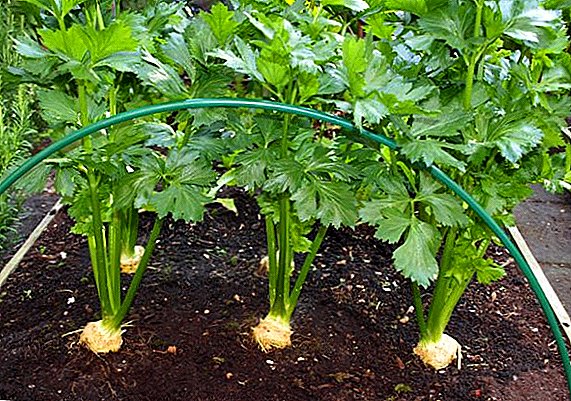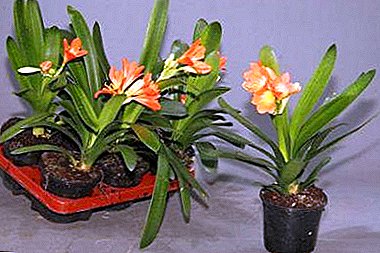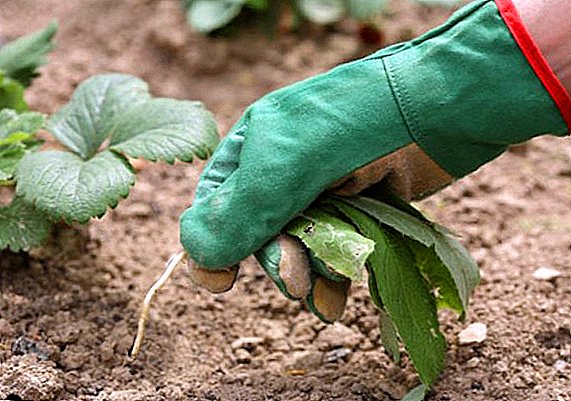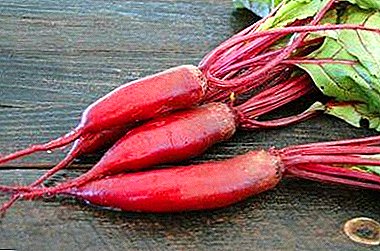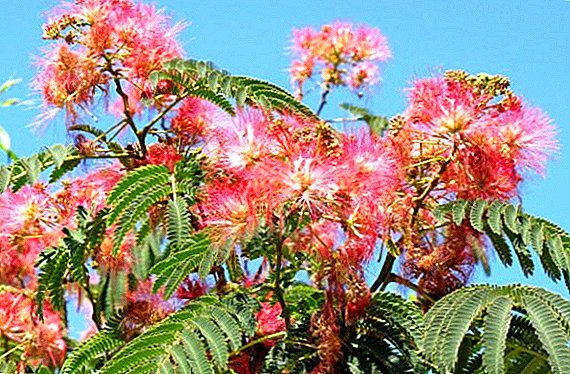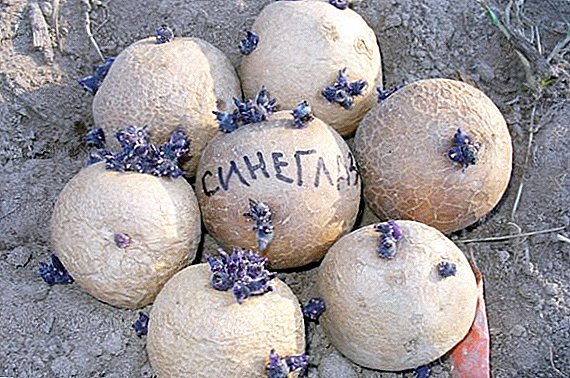 Potatoes - one of the most common vegetables. Today there are a huge number of its varieties, and everyone can choose a product to your taste.
Potatoes - one of the most common vegetables. Today there are a huge number of its varieties, and everyone can choose a product to your taste.
In our article we will talk about the variety "Sineglazka", which is very popular and has a pleasant taste.
Breeding history
"Sineglazka" is a hybrid variety, which was bred as a result of the crossing of several cultivated varieties with wild. It was bred by breeder S. Demin in the late 1940s. "Sineglazka" got the number 15555 in the list of varieties of the Institute of Starch Products.
Important! In order to get a good harvest every year, you shouldn’t plant only those tubers that were grown on your own - every 2-3 years the variety needs to be fully updated.Hybrid tests were conducted at various stations, where they received high marks from specialists.

Botanical description of tubers
Potatoes "Sineglazka" refers to a group of mid-season varieties, the tubers are colored beige and have purple eyes. Vegetable differs oval-oblong shape, smooth skin. The flesh on the cut is colored white, the starch content is up to 15.5%. On average, the weight of one tuber is 150-200 g.
The hybrid has a great taste, it can be cooked, baked, mashed. The flesh has a crumbly, delicate structure and a pleasant rich flavor.
The variety is characterized by a long growing season, with the formation of tubers have the correct shape and the same size.
Characteristic variety
Each type of potato has its own distinctive characteristics that allow you to choose a vegetable for growing in specific conditions, as well as on the basis of its taste. 
Disease resistance
Unlike many varieties, "Sineglazka" has resistance to such diseases:
- potato cancer;
- scab;
- nematode;
- viral infections;
- late blight.
Precocity
"Sineglazka" is characterized by a long growing season, ripening takes place in July and lasts until the last decade of September. The first crop can be harvested within 90-110 days after planting. The exact time depends on the time at which the landing was made and what the weather conditions were.
To prepare dishes from potatoes, you can dig it in the middle of July, but if you plan a long-term storage of vegetables, then digging should be done in early September. 
Yield
The amount of the harvest depends on how good the planting material was, what weather conditions were present, whether the soil was sufficiently nutritious. However, in general, the variety belongs to high-yielding - up to 500 kg of vegetables can be collected from one weave.
Growing regions
Effective cultivation of this variety is noted in the central part of Russia, Ukraine, Belarus.
Landing rules
To ensure that the plant is well rooted and has given a good harvest in the future, special attention should be paid to the time of planting.
Agree that before you get a big crop, you should plant potatoes. We advise you to consider when it is best to plant potatoes in open ground and how to plant potatoes before winter.
Optimal timing
Ideally, the Sineglazki should land in mid-May, but due to weather conditions this period may shift slightly. Gardeners are often guided by birch leaves - immediately after their blooming, you can start planting.  It is very important that at the time of planting the soil is well warmed up - at a depth of 10 cm its temperature should be + 6-8 ° C. If the temperature is lower, the growth of tubers will be slow. For normal plant development, the average daily air temperature indicator should not be below +10 ° C.
It is very important that at the time of planting the soil is well warmed up - at a depth of 10 cm its temperature should be + 6-8 ° C. If the temperature is lower, the growth of tubers will be slow. For normal plant development, the average daily air temperature indicator should not be below +10 ° C.
Location selection
For the landing of "Sineglazki" is to choose a site with good lighting, which most of the daytime will be the sun's rays. If you plant a plant among the trees, it will lead to the fact that the bushes will be weak and elongated, and in the end will not give a good harvest.
Did you know? Potatoes - poisonous plants. Having eaten only 1-2 immature potatoes, you can get poisoning solanine.Also it is necessary to abandon the territory with a close location of groundwater - as a result of flooding, little oxygen will flow into the root system and the bush will die. It is important to ensure that the site is protected from strong winds.
 The soil in which planting is planned, should be light, loose and fertile, have a neutral acidity. Ideal for growing light loam. It perfectly provides the root system with air and moisture. Potatoes can also be planted on sandy soil, but in this case, during soil preparation, it is worth adding nutrients to it, and then watering more frequently.
The soil in which planting is planned, should be light, loose and fertile, have a neutral acidity. Ideal for growing light loam. It perfectly provides the root system with air and moisture. Potatoes can also be planted on sandy soil, but in this case, during soil preparation, it is worth adding nutrients to it, and then watering more frequently.Good and bad predecessors
In order to prevent various diseases of potatoes and increase their productivity, it is important to know the rules of compatibility of vegetables. Ideal for planting "Sineglazki" suitable areas on which previously grown:
- roots;
- cabbage;
- legumes;
- pumpkin;
- cucumbers.
 If on the planned plot of planting previously grown tomatoes, peppers or eggplants, it is recommended to choose another place for potatoes. It is not necessary to place these vegetables and near potatoes. Due to their belonging to the same family, there is an active accumulation of diseases and pests that are transmitted to neighbors.
If on the planned plot of planting previously grown tomatoes, peppers or eggplants, it is recommended to choose another place for potatoes. It is not necessary to place these vegetables and near potatoes. Due to their belonging to the same family, there is an active accumulation of diseases and pests that are transmitted to neighbors.Familiarize yourself with all the subtleties of growing potatoes in sacks, using Dutch technology and under straw.
It is possible to plant a vegetable in one place after 2-3 years. However, it is not always possible to adhere to this rule. In this case, use some secrets that contribute to the restoration of the soil. In this area, immediately after harvesting potatoes, it is worth planting cereals, ideally oats.
It contributes to the suppression of pathogens and disinfects the soil. For the winter period, the culture will rot, and with the arrival of spring it can be embedded in the ground. 
Soil preparation
Soil preparation consists in digging it, which is carried out 2 times.
In the autumn period, it is worth freeing the land for planting from weeds and vegetation, spread manure or humus at the rate of up to 6 kg per 1 meter. It is imperative to carry out deep digging, at the same time rhizomes of weeds are extracted from the soil. Large lumps of land should not be broken if possible.
Usually, the upper layers of the soil provide a good shelter for the pests that settle in it for the winter. Under the influence of low temperature, they will quickly die, and strong winds and precipitation will contribute to the disintegration of large lumps.
Important! When harvesting, it is important to remove all tubers from the soil, as the potatoes remaining in the ground will decompose and attract insects.In the spring, digging is to start in early April. It is not necessary to do a deep digging, it will be enough to deepen the shovel by 15 cm. But in the spring it is worth carefully breaking all the clumps of soil into small particles. Before proceeding to the treatment of the soil, it is necessary to disperse the nitrogen content on the surface of the fertilizer, as well as complex ones. The norm is worth looking at the packaging.
 Sometimes gardeners prefer to make useful substances in the hole or trench when disembarking. If you decide to use this method - carefully mix the fertilizer with the soil, and only then lay down the tubers.
Sometimes gardeners prefer to make useful substances in the hole or trench when disembarking. If you decide to use this method - carefully mix the fertilizer with the soil, and only then lay down the tubers.Preparation of planting material
In order to get a good harvest, you should use only high-quality tubers for planting. They should be of medium size; no damage or symptoms of disease are allowed.
Two methods of disembarkation are practiced - with and without preliminary preparation of tubers. However, by sprouting tubers, you can get a harvest a few weeks earlier. Sprouting includes the following steps:
- 3-4 weeks before the intended landing, it is necessary to sort the tubers and reject the damaged ones;
- in the presence of dried earth on the tubers, it is removed. To do this, they are soaked in a basin of water;
- Then clean the tubers should be placed in shallow boxes and left under ambient light. If it is possible to place the potatoes in the room on the floor - lay it in a single layer;
- optimal temperature for germination - + 12-15 ° C;
- once in 7 days, the tubers are turned over and slightly sprinkled with water, the room should be ventilated;
- tangles with sprout length not less than 1 cm are considered to be ready for planting.
 Before planting potatoes, it is necessary to fumigate it with the help of ash, spray it with copper sulphate and boric acid at the rate of 1 g per 10 l of water.
Before planting potatoes, it is necessary to fumigate it with the help of ash, spray it with copper sulphate and boric acid at the rate of 1 g per 10 l of water.Scheme and depth of landing
Shrubs "Sineglazki" need good lighting, so when disembarking you should leave a distance of 60-70 cm between rows. The glomeruli themselves should be planted every 40 cm. Using such a planting scheme will ensure the normal development of the rhizome.
Did you know? The first person in Russia who tasted potatoes was Peter I.If the landing is carried out in a light, loose soil, the depth of the hole should be 10 cm. In order to achieve a smooth row, the landing is carried out on a rope. If there is a large amount of clay in the soil and it is quite dense, it costs 7-8 cm to plant the potatoes.
 If the flooded areas are chosen for planting, drainage ditches must be made without fail so that excess water can easily escape.
If the flooded areas are chosen for planting, drainage ditches must be made without fail so that excess water can easily escape.Consider all the features of growing potato varieties such as Meteor, Romano, Krasa, Black Prince, Riviera, Colombo and Courage.
How to care
Caring for potatoes is the proper watering, loosening and dressing. Consider how to perform these activities.
Watering
To obtain a large crop, it is important to follow the recommendations for watering the plant. For "Sineglazki" moderately moist soils are well suited. It is important to take into account that the lack of moisture and its excess will negatively affect the plant.
Unfortunately, the weather is not very stable - in one season there can be abundant and frequent rains, and in the other - drought prevail. Determine when "Sineglazka" needs to be moistened, it is possible by the way the plants and the soil look. When the soil dries up to 10 cm in depth, as well as when the bush is wilted, it is recommended to perform watering.  In a season with an average amount of precipitation, it is necessary to water the plants approximately 3 times during the whole growing season. Between irrigation should be one and a half to two weeks breaks. Basic irrigation carried out:
In a season with an average amount of precipitation, it is necessary to water the plants approximately 3 times during the whole growing season. Between irrigation should be one and a half to two weeks breaks. Basic irrigation carried out:
- after shoots appear;
- during bud formation;
- after the end of the flowering period.
Ideally, a hose should be used, at the end of which there is a sprayer - in this way the beds will not be washed out. To save water, you can carry out drip irrigation. 
Top dressing
If during the preparation of the potato were made the necessary fertilizers, plant feeding in the growing season is not carried out. However, we should not forget that in the formation of tubers, they need nitrogen, phosphorus and potassium. With a lack of these minerals, the quality of vegetables is significantly reduced, therefore, completing additional feeding, you can achieve a better crop.
Important! Do not overdo it with irrigation and fertilizer - their excess will lead to the tops that will grow too quickly, and the tubers will be small.The first phase of growth "Sineglazki" needs minerals, so when digging in the spring or in the well is to make fertilizers that contain nitrogen - they will contribute to good growth. These include nitroammofosku.
 Nitroammofosk as nitrogen fertilizer In the second half of the growing season, potatoes need organic nutrition. Manure is used for fertilizer, which is applied according to the following standard: 3-5 kg per 10 square meters. Effective is the use of chicken litter. It is necessary to dry and grind to a powder, make 5 kg per 10 square meters.
Nitroammofosk as nitrogen fertilizer In the second half of the growing season, potatoes need organic nutrition. Manure is used for fertilizer, which is applied according to the following standard: 3-5 kg per 10 square meters. Effective is the use of chicken litter. It is necessary to dry and grind to a powder, make 5 kg per 10 square meters.Agree, correctly using the fertilizer for potatoes, you can increase it at times. Read about what fertilizers are suitable for potatoes.
Also practiced making dressings in the form of a solution. To do this, dilute the manure with water 1 to 5, chicken manure - 1 to 15. Organic fertilizers are applied only after moistening or before hilling.
Weeding and loosening the soil
After each watering it is important to loosen the soil. This event is aimed at the destruction of the crust formed, which prevents gas exchange in the root system.
In addition, it is necessary to regularly destroy weeds that grow between the rows and bushes. Processing of soil between the rows should stop with the beginning of the mass flowering plants. However, if it rains frequently, loosening should be done to ensure air flow to the tubers. 
Hilling
Hilling is one of the main stages of plant care. It should be carried out at least 2 times during the whole growing season.
- The first time the procedure is carried out immediately after the height of the tops reaches 15-20 cm. With a properly conducted event, you will receive a shrub that will be covered with soil for a third - only about 5 cm of haulm will look out.
- The second time hilling is done before the potatoes begin to bloom. This period begins 2-3 weeks after the first treatment.
It will probably be useful for you to find out when spuding potatoes for the first time, as well as familiarize yourself with the rules for spuding potatoes with a walker.
If the air temperature during the day is too high, the event should be done in the evening. Ideally, hilling should be done after watering or rain. 
Harvesting and storage
You should not start digging a vegetable if it rains heavily. To collect, it is better to wait until dry weather is established, and before digging it is necessary to mow the tops for 2 weeks, leaving about 10 cm above the soil. This is necessary to stop the outflow of nutrients and improve maturation.
In order not to damage the potatoes when digging, it is recommended to use forks, so the tubers will not be damaged. After harvesting, it is necessary to leave the crop outside for a few hours so that the potatoes can dry thoroughly. After that, it should be moved under a shed and perform sorting.  We dig up potatoes with the help of a fork. Tubers that have damage are usually used for consumption, and high-quality potatoes are packed in containers and left in a dark place where the temperature should be maintained at + 15-18 ° С. In about 1 month the peel will become firmer, the taste of the vegetable will improve.
We dig up potatoes with the help of a fork. Tubers that have damage are usually used for consumption, and high-quality potatoes are packed in containers and left in a dark place where the temperature should be maintained at + 15-18 ° С. In about 1 month the peel will become firmer, the taste of the vegetable will improve.
At this time it is worth moving the potatoes to a permanent storage place. The average temperature in the room should be about +2 ° C, and the humidity should be in the range of 85-90%.
Did you know? The world leaders in eating potatoes are Belarusians: for one year one resident of the country eats 183 kg.It is important to provide good ventilation in the room. Periodically it is worth sorting out the tubers, tearing off the sprouts and removing the rotted potatoes.
 Fingering potatoes
Fingering potatoesAdvantages and disadvantages
Sort "Sineglazka" has a lot of advantages, namely:
- has excellent yields;
- has excellent taste;
- resistant to many diseases;
- easy to care for growing.
- possesses poor lezhkost;
- prone to damage by the wireworm;
- quickly degenerates, it is quite difficult to find planting material.


